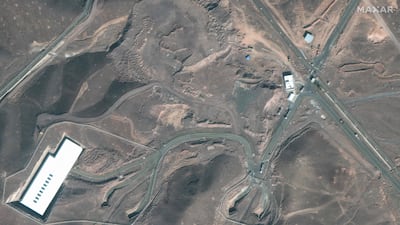Fordow was Iran’s nuclear stronghold, and more than just a uranium enrichment site. It was a symbol of defiance and a bargaining chip in nuclear diplomacy.
The site's fate is uncertain after several 30,000-pound US bunker bombs had been dropped on it. Iranian state media confirmed that part of the Fordow nuclear site area "was attacked by the enemy".
The site became the central flashpoint in the conflict between Iran and Israel and the US. Israeli officials reportedly viewed it as a priority target in their campaign to cripple Iran’s nuclear infrastructure and were pressuring Washington to intervene militarily to help neutralise it.
The site’s extreme fortification made it nearly impossible to attack without advanced bunker-busting weaponry, something only the US possesses.
Where is it?
The Fordow Fuel Enrichment Plant (FFEP) is located roughly 32 kilometres south of Qom, in the rugged terrain near the small village of Fordow, in central Iran’s Markazi province.
It is deep into the side of a mountain, adjacent to a military base operated by the Islamic Revolutionary Guard Corps (IRGC).
This seems to be no accidental placement: Qom is Iran’s religious capital, home to its most powerful clerics. By anchoring its most sensitive nuclear site here, Iran symbolically tied its atomic ambitions to its religious and ideological core.
Why was it the 'crown jewel'?
Fordow has often been called the crown jewel of Iran’s nuclear programme. The title comes not from size but from strategic survivability, secrecy, and symbolism.
It was one of the most heavily fortified nuclear facilities in the world. Buried under 80 to 100 metres of rock and reinforced concrete, it was designed to withstand military strikes, including those from bunker-buster bombs.
According to weapons analysts, only the US GBU-57 Massive Ordnance Penetrator – a 15-tonne bomb – had a chance of breaching it. Israeli bombs, by contrast, are widely considered insufficient for the job.
"Iran's key nuclear enrichment facilities have been completely and totally obliterated," said President Donald Trump following the strikes on Fordow and other Iranian nuclear sites.
Fordow was built in secret in the mid-2000s and only revealed in 2009 after western intelligence agencies exposed its existence. Iran confirmed the site under pressure, but the episode fed suspicions that Tehran was pursuing a covert path to a nuclear weapon.

What happens inside?
At its core, Fordow was a uranium enrichment facility. This means it was not producing bombs or warheads, but spinning centrifuges that increase the concentration of fissile isotopes in uranium.
It was originally meant to enrich uranium up to 20 per cent for the Tehran Research Reactor. But it was enriching uranium to 60 per cent before the US strikes, a level approaching weapons-grade.
It hosted both older IR-1 centrifuges and more advanced IR-6 machines, and was estimated to have 100–200 nuclear engineers, technicians, and support personnel, many trained at elite universities.
What about IAEA access?
The International Atomic Energy Agency (IAEA) has visited Fordow several times.
Under the 2015 Joint Comprehensive Plan of Action (JCPoA), Iran agreed to suspend enrichment at Fordow and convert the facility to a research centre. The IAEA installed surveillance equipment, and inspectors visited regularly.
But in 2019, Iran resumed enrichment at the site in response to the US withdrawal from the JCPoA. Since 2023, Iran has reduced IAEA access, and in 2024 expelled several senior inspectors.
Do the US strikes risk a radiation leak?
Pete Bryant, honorary professor in physics at the University of Liverpool, told The National that Fordow is a uranium enrichment facility, not a nuclear power plant, and therefore cannot experience a nuclear meltdown of the kind seen at Fukushima in Japan or Chernobyl in Soviet Ukraine.
“It's important to distinguish between nuclear power plants and uranium enrichment facilities, as they are fundamentally different in function, design, and risk,” he said.
“Chernobyl and Fukushima were full-scale nuclear reactor incidents under very specific, high-risk conditions. Iran’s uranium enrichment facilities are not reactors, do not have comparable inventories of radioactive material, and cannot experience similar failures.”
Iran’s Nuclear Safety System Centre said “no nuclear contamination” was detected around nuclear sites following US attacks.

